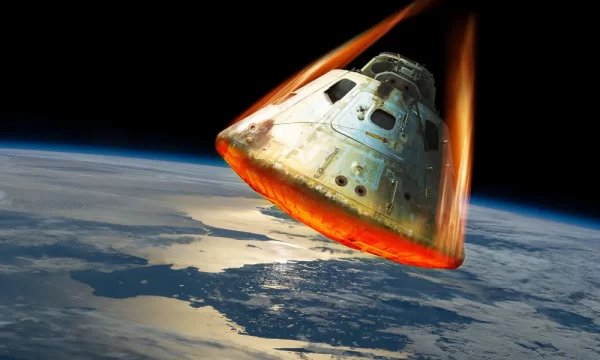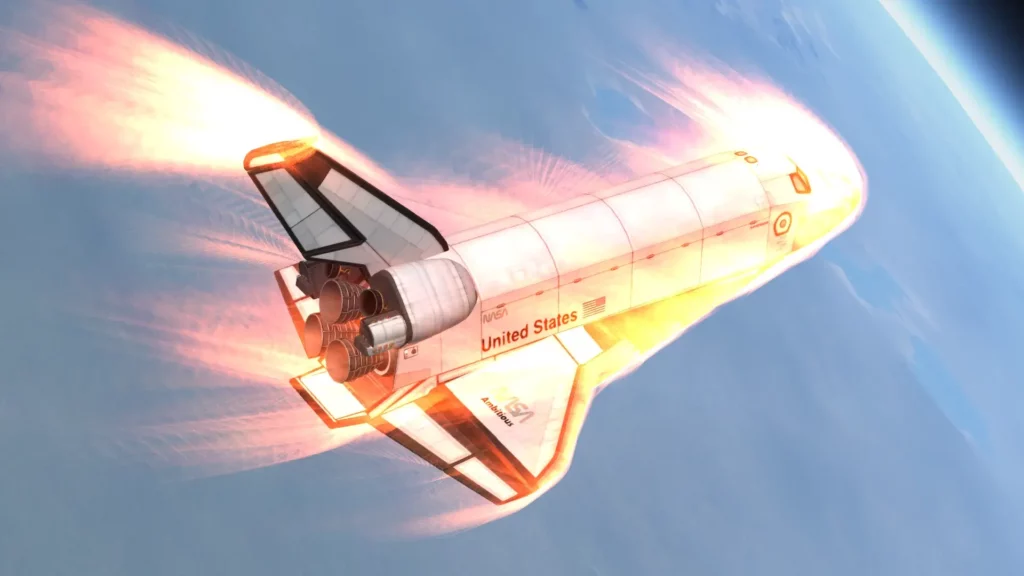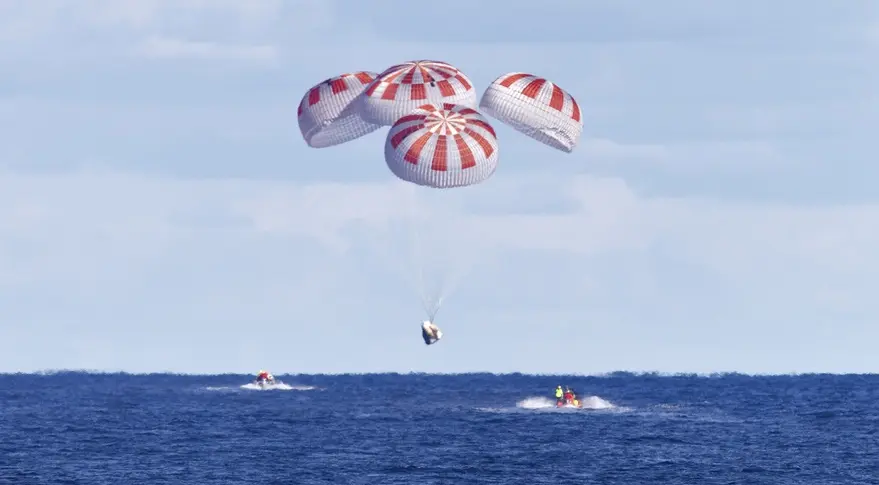
The re-entry: How do astronauts get back to earth?
Last Updated: June 19, 2023
As of January 2023, over 600 people have been to space, and those numbers are continuing to rise, particularly with the privatization of spaceflight. But what happens when your time in space is completed?
How do you come back to Earth? Let’s go over the process of re-entry including the concerns and technological requirements of spacecraft along with the experiences of astronauts.
The Fundamentals of Re-entry: Understanding the Process of Entering Earth's Atmosphere
When an object from space enters Earth’s atmosphere, it hits the gas molecules that make up the air in our atmosphere. Anything moving through the atmosphere has to move the molecules out of the way to get through. We don’t have to really worry about this until we get close to Mach 1, the sound barrier when molecules can’t get out of the way fast enough and the object has to break through the “wall” of molecules in its way which results in a sonic boom.
A spacecraft entering from low Earth orbit falls at about Mach 25 or 25 times the speed of sound. This is fast enough to break apart the chemical bonds of the air molecules, creating an electrically charged plasma around the spacecraft. This plasma is extremely hot and spacecraft need special thermal barriers or heat shields to protect them and their occupants during re-entry.
So, how do different spacecraft handle the physical requirements of re-entry?
Atmospheric re-entry for spacecraft
An important aspect to remember is that the requirements for launch are basically the opposite of the requirements for re-entry. During the launch, we want to reduce drag as much as possible to increase thrust and lift, often resulting in the typical rocket shape. However, during re-entry, we need to increase drag to reduce our speed, utilizing a preferably broad, blunt design.
Let’s go over how different spacecraft handle re-entry:
The Space Shuttles
On the space shuttle, special silicone tiles on the aluminum skin helped provide insulation, but on the nose and edges of the wing where it would get hottest was a reinforced carbon-carbon (RCC) composite. (Columbia’s RCC was damaged during liftoff which caused it to burn up during reentry and was the reason for the Columbia disaster.)
The shuttles were gliders, meaning they were able to adjust their flight pattern to help reduce the amount of heat building up including S turns, making re-entry not too dissimilar from landing in an airplane.
- First, the shuttle flew backward to slow down from orbit speed, and then the orbital maneuvering engines (OMS) would thrust it out of orbit and toward Earth.
- Next, the shuttle turned nose-first once out of orbit and entered the atmosphere with its belly down toward the atmosphere to use drag along its blunt bottom to help slow it down and then pull the nose up to about 40 degrees.
- It utilized S turns and other flight patterns to increase drag, reduce speed, and reduce the heat that built up from the re-entry into the atmosphere.
- The shuttle would then land similar to airplanes on runways with landing gear and a parachute deployed while rolling down the strip to help slow it down even further from about 200 mph.
- The rescue teams would then assist the crew with egressing the space shuttle, including medical checks by flight surgeons.

Image Credit: Kerbal Space Program / u/The_Black_Badger_KSP on reddit
Ballistic capsules
Essentially, ballistic capsules are rockets and the parts of the spacecraft that astronauts ride back to Earth. These include spacecraft such as the Mercury, Gemini, Apollo, Shenzhou, and Soyuz programs that use ablative heat shields made of a special ceramic material designed to slowly burn away as the spacecraft encounters the high-temperature plasma flow in front of the bowshock associated with re-entry.
Astronauts often describe re-entry with ballistic capsules as a series of car crashes as opposed to the smooth glider-like landing of the space shuttle.
The journey back to Earth aboard a Soyuz vehicle takes about 3.5 hours.
- After closing the hatch and sealing the vehicle away from the ISS, springs launch the vehicle away from the space station.
- Engines fire for almost 5 minutes to stop it from orbiting Earth, decelerating it from the 17,500 mph orbital speed of the ISS and decreasing its orbit to re-enter the atmosphere.
- The Soyuz separates into three parts: the orbital module, the descent module, and the instrument compartment/ service module, the first and last of which burn up in the denser layers of the atmosphere, while only the descent module with the astronauts returns to Earth.
- As the atmosphere slows the capsule down, astronauts are pushed into their seats, feeling up 5x their weight in pressure.
- Parachutes reduce the speed even more.
- Rockets fire just before touchdown and shock-absorbing seats soften the landing, often at about 5 km/hr.
- Rescue teams open the hatch and help the astronauts out.
Parachute descent with a splashdown in the ocean is often used, but landing on land is also common.
SpaceX Dragon
With NASA’s recent partnership with SpaceX, SpaceX Dragon has become the standard spacecraft for ferrying astronauts and supplies to and from space. Similar to the Soyuz re-entry to Earth, SpaceX Dragon works as a ballistic capsule, and the following breakdown is taken from the Axiom-1 descent footage.
- First, astronauts initiate a downhill phase burn of Dragon’s Draco thrusters to lower the altitude.
- Next, the “trunk” (the cylindrical unpressurized portion on the aft) separates to reveal the heat shields, and Dragon switches to battery power.
- There is a de-orbit burn of about 10 minutes to return to Earth using forward bulkhead thrusters which then shut down.
- Astronauts close and lock the nose cone in prep for re-entry.
- Atmospheric re-entry begins, including a brief loss of communications (about 7 mins). Nitrox is used to cool the interior and the ablative heat shields are utilized on the outside of the craft during descent through the atmosphere.
- 2 Drogue (minor) Parachutes deploy at about 18,000 ft to stabilize and decelerate the craft, followed by the 4 main parachutes less than a minute later at about 1,000 ft to further slow down the spacecraft.
- Over the course of 3 minutes, these parachutes bring the speed from 350 mph to about 15 mph for splashdown/ landing.
- The rescue team retrieves the capsule, utilizing a hydraulic lift system to place it on a boat before repressurizing the cabin safely and then opening the hatch.
- The medical doctor/flight surgeon is the first one in to check on the astronauts, followed by the rescue crew who reminds the crew of the egress procedures.
- They are then assisted out of the capsule with the help of the Rescue Crew, often with a chance for photos and on live video, and immediately escorted to medical bays to address any concerns.
NASA’s Low-Earth Orbit Flight Test of an Inflatable Decelerator, or LOFTID
One of NASA’s newest options for atmospheric re-entry is a flying saucer-shaped inflatable aeroshell with a flexible heat shield, making it easy to collapse into a rocket for launch and then deploy for the maximum surface area as a heat shield during re-entry.
This inflatable decelerator is being developed for Mars missions since Mars has a much thinner atmosphere, meaning it won’t be able to help us decelerate on arrival like re-entry into Earth’s atmosphere. The fully inflated decelerator will help increase drag to slow down the craft and provide a safe, soft landing.
The Inflatable Decelerator had a successful test on November 10th, 2022 and we look forward to more news about its testing and deployment for future human spaceflight missions.

SpaceX Dragon capsule landing at sea. Image Credit: NASA/Cory Huston.
Astronauts’ experiences of re-entry
Re-entry is the culmination of the mission and while astronauts are excited to return home, re-entry is a thrilling experience, different from launch, but just as crucial and potentially hazardous. It requires immense effort from both the astronauts and ground support to ensure that they make it back safely.
As we’ve discussed previously in our article on astronaut training for Zero-G environments, the lack of gravity causes muscles to deteriorate since they aren’t being used in space due to the lack of gravity. Many astronauts struggled upon their return to Earth as their muscles had to be retrained to Earth’s gravity,
However, thanks to the modern exercise routines utilized on the ISS, re-entry to Earth is an easier transition for astronauts today. They can often walk with a little support from the crew, although their body still needs time to readjust to life with Earth’s gravity. It is still normal procedure to have astronauts taken away on stretchers to assist in this transition.
After they pass the initial and then more detailed medical checks after touchdown, they are flown back to meet their families. Media interviews may also be conducted at this time. The space agencies allow the astronauts some time off, but also continue to check in with the astronauts for medical check-ups and physical therapy to help them readjust to life back on Earth. Media interviews often continue for the next several weeks as we want to hear about their mission and return home in more detail.
What does the re-entry looks like from Earth?
In the below video, you can see what the re-entry of a crewed spacecraft looks like from Earth. You can see that it is fairly impressive, it really does look like a rain of fire coming down from the sky. You can just imagine the immense energy discharged as the capsule fiercely interacts with the atmospheric molecules during its descent.
The subsequent video demonstrates the graceful parachute landing, a culmination of intricate engineering and precise calculations, capturing the spacecraft’s final descent into a quiet denizen of the Earth.
👀 Fiery Shenzhou-15 reentry spotted over Korla, Xinjiang https://t.co/8ytaPzbkSw https://t.co/XPv8fg6yjD pic.twitter.com/5T8ibf9h92
— China 'N Asia Spaceflight 🚀🛰️🙏 (@CNSpaceflight) June 4, 2023
Conclusion
After spending time in space, a safe re-entry into Earth’s atmosphere is essential to return home. NASA and other space agencies have used a number of different spacecraft and innovations to provide a safe return from space including the space shuttle program, the ballistic capsules still used today, and the inflatable decelerator that is being developed for human spaceflight missions to Mars.
Atmospheric re-entry is a crucial part of spaceflight and researchers continue to develop different innovations and procedures to make it as safe as possible.

Sarah Hoffschwelle is a freelance writer who covers a combination of topics including astronomy, general science and STEM, self-development, art, and societal commentary. In the past, Sarah worked in educational nonprofits providing free-choice learning experiences for audiences ages 2-99. As a lifelong space nerd, she loves sharing the universe with others through her words. She currently writes on Medium at https://medium.com/@sarah-marie and authors self-help and children’s books.
Explore more astronaut stories 👨🚀
This page is part of our collection of articles about astronauts. If you enjoyed the read, then you’ll love the following articles.



The requirements to become an astronaut are extremely rigorous. Does their salary match the difficulty of their profession?

There are three main reasons why astronauts may have difficulty walking on land after spending so much time in a microgravity environment.
